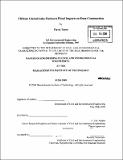Chilean glacial lake outburst flood impacts on dam construction
Author(s)
Tauro, Flavia
DownloadFull printable version (47.95Mb)
Other Contributors
Massachusetts Institute of Technology. Dept. of Civil and Environmental Engineering.
Advisor
E. Eric Adams.
Terms of use
Metadata
Show full item recordAbstract
Four Glacial Lake Outburst Floods (GLOF) occurred in the Colonia Glacier (Northern Patagonia Icefield, Chile) from April 2008 to March 2009. Lago Cachet 2 emptied four times producing a maximum excess discharge in the downstream Rio Baker of about 2,500 m3/s. These events have occurred at the same time as the proposal by HidroAysen to install two dams on the Rio Baker to produce hydropower. The aim of this thesis is to investigate the GLOF mechanisms and to estimate the magnitude of outburst flows to better understand their effect on the feasibility of the HidroAysen project. A temperature balance model for Lago Cachet 2 is developed to estimate the lake temperature before an outburst. These temperatures become inputs for the modified Clarke's model that predicts peak discharge of the lake given its geometry. The temperature model gave a lake temperature in January equal to 7.4 °C degrees that produces a peak discharge of approximately 2,000 m3/s, somewhat lower than the one registered at the confluence of the Rio Colonia with the Rio Baker (the station registered a peak discharge of 2,500 m3/s). A sensitivity analysis of the model to the various inputs suggests that model accuracy could be improved with more information about the geometry of Lago Cachet 2 and meteorological data. The study also illustrates how air temperature influences the melting of the Colonia Glacier and how the temperature trend is responsible for the GLOF frequency. A possible future scenario is proposed for Lago Cachet 2.
Description
Thesis (M. Eng.)--Massachusetts Institute of Technology, Dept. of Civil and Environmental Engineering, 2009. Includes bibliographical references (leaves 80-82).
Date issued
2009Department
Massachusetts Institute of Technology. Department of Civil and Environmental EngineeringPublisher
Massachusetts Institute of Technology
Keywords
Civil and Environmental Engineering.